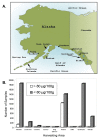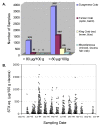Non-traditional vectors for paralytic shellfish poisoning
- PMID: 18728730
- PMCID: PMC2525492
- DOI: 10.3390/md20080015
Non-traditional vectors for paralytic shellfish poisoning
Abstract
Paralytic shellfish poisoning (PSP), due to saxitoxin and related compounds, typically results from the consumption of filter-feeding molluscan shellfish that concentrate toxins from marine dinoflagellates. In addition to these microalgal sources, saxitoxin and related compounds, referred to in this review as STXs, are also produced in freshwater cyanobacteria and have been associated with calcareous red macroalgae. STXs are transferred and bioaccumulate throughout aquatic food webs, and can be vectored to terrestrial biota, including humans. Fisheries closures and human intoxications due to STXs have been documented in several non-traditional (i.e. non-filter-feeding) vectors. These include, but are not limited to, marine gastropods, both carnivorous and grazing, crustacea, and fish that acquire STXs through toxin transfer. Often due to spatial, temporal, or a species disconnection from the primary source of STXs (bloom forming dinoflagellates), monitoring and management of such non-traditional PSP vectors has been challenging. A brief literature review is provided for filter feeding (traditional) and non-filter feeding (non-traditional) vectors of STXs with specific reference to human effects. We include several case studies pertaining to management actions to prevent PSP, as well as food poisoning incidents from STX(s) accumulation in non-traditional PSP vectors.
Keywords: PSP; SPFP; STXs; crustaceans; gastropods; non traditional vectors; paralytic shellfish poisoning; public health; puffer fish; saxitoxin puffer fish poisoning; saxitoxins.
Figures


References
-
- Oshima Y. Chemical and enzymatic transformation of paralytic shellfish toxins in marine organisms. In: Lassus P, Arzul G, Erard-Le-Denn E, Gentien P, Marcaillou-Le-Baut C, editors. Harmful Marine Algal Blooms. Technique et Documentation, Lavoisier; Paris: 1995. pp. 475–480.
-
- Cembella AD, Shumway SE, Lewis NI. Anatomical distribution and spatio-temporal variation in paralytic shellfish toxin composition in two bivalve species from the Gulf of Maine. J Shellfish Res. 1993;12:389–403.
-
- Onodera HY, Oshima Y, Watanabe MF, Watanabe M, Bolch CJ, Blackburn S, Yasumoto T. Screening of paralytic shellfish toxins in freshwater cyanobacteria and chemical confirmation of the toxins in cultured Anabaena circinalis from Australia. In: Yasumoto T, Oshima Y, Fukuyo Y, editors. Harmful and Toxin Algal Blooms. Intergovernmental Oceanographic Commission of UNESCO; Paris: 1996. pp. 563–566.
-
- Sullivan JJ. Methods of analysis for algal toxins: dinoflagellate and diatom toxins. In: Falconer IR, editor. Algal Toxins in Seafood and Drinking Water. Academic Press; London: 1993. pp. 29–48.
-
- Onoue Y, Nozawa K. Zinc-bound PSP toxins separated from Cochlodinium red tides. In: Natori S, Hashimoto K, Ueno Y, editors. Mycotoxins and Phycotoxins ’88. Elsevier; Amsterdam: 1989. pp. 359–366.
Publication types
MeSH terms
Substances
LinkOut - more resources
Full Text Sources
Other Literature Sources
Medical
Miscellaneous
